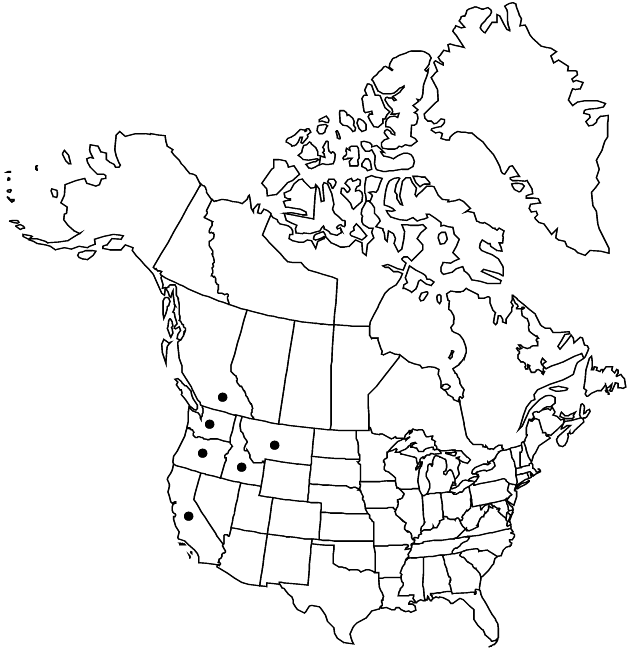Difference between revisions of "Psilocarphus elatior"
in A. Gray et al., Syn. Fl. N. Amer. ed. 2, 1: 448. 1886.
FNA>Volume Importer |
FNA>Volume Importer |
||
| Line 27: | Line 27: | ||
|elevation=0–1700 m | |elevation=0–1700 m | ||
|distribution=B.C.;Calif.;Idaho;Mont.;Oreg.;Wash. | |distribution=B.C.;Calif.;Idaho;Mont.;Oreg.;Wash. | ||
| − | |discussion=<p>Psilocarphus elatior occurs west of the Cascade Range from California to Vancouver Island, British Columbia, and in scattered areas eastward (northwestern Montana, mountains surrounding the border area common to Oregon, Washington, and Idaho). Reports of P. elatior from Alberta and Saskatchewan were based on relatively erect forms of P. brevissimus var. brevissimus. Psilocarphus elatior has been of conservation concern in Canada (J. M. Illingworth and G. W. Douglas 1994).</p><!-- | + | |discussion=<p><i>Psilocarphus elatior</i> occurs west of the Cascade Range from California to Vancouver Island, British Columbia, and in scattered areas eastward (northwestern Montana, mountains surrounding the border area common to Oregon, Washington, and Idaho). Reports of <i>P. elatior</i> from Alberta and Saskatchewan were based on relatively erect forms of <i>P. brevissimus </i>var.<i> brevissimus</i>. <i>Psilocarphus elatior</i> has been of conservation concern in Canada (J. M. Illingworth and G. W. Douglas 1994).</p><!-- |
| − | --><p>Where sympatric, Psilocarphus elatior tends to inhabit relatively dry or seasonally flooded sites in more mesic coastal or montane climates and P. brevissimus var. brevissimus occurs mainly in wetter, seasonally inundated sites in semiarid climates. Some specimens appear to be intermediate; further study may show the two taxa to be better treated as varietally distinct. See also under P. brevissimus var. multiflorus.</p> | + | --><p>Where sympatric, <i>Psilocarphus elatior</i> tends to inhabit relatively dry or seasonally flooded sites in more mesic coastal or montane climates and <i>P. brevissimus </i>var.<i> brevissimus</i> occurs mainly in wetter, seasonally inundated sites in semiarid climates. Some specimens appear to be intermediate; further study may show the two taxa to be better treated as varietally distinct. See also under <i>P. brevissimus </i>var.<i> multiflorus</i>.</p> |
|tables= | |tables= | ||
|references= | |references= | ||
| Line 52: | Line 52: | ||
|publication year=1886 | |publication year=1886 | ||
|special status= | |special status= | ||
| − | |source xml=https://jpend@bitbucket.org/aafc-mbb/fna-data-curation.git/src/ | + | |source xml=https://jpend@bitbucket.org/aafc-mbb/fna-data-curation.git/src/8f726806613d60c220dc4493de13607dd3150896/coarse_grained_fna_xml/V19-20-21/V19_762.xml |
|tribe=Asteraceae tribe Gnaphalieae | |tribe=Asteraceae tribe Gnaphalieae | ||
|genus=Psilocarphus | |genus=Psilocarphus | ||
Revision as of 16:14, 18 September 2019
Plants greenish gray to silvery, ± sericeous. Stems 1(–3), ± erect; proximal internode lengths mostly 0.5–1.5(–2) times leaf lengths. Capitular leaves ± erect, appressed to heads, mostly oblanceolate to nearly linear, widest in distal 1/3, longest mostly 17–35 mm, lengths mostly 4.5–9 times widths, 2.5–5 times head heights. Heads ± spheric, largest 6–8 mm. Receptacles unlobed. Pistillate paleae collectively ± hidden by indument, longest 2.8–3.8 mm (lengths 1.5–3 times longest diams.; wings supramedian). Staminate corollas 1.3–1.9 mm, lobes 5. Cypselae ± cylindric, terete, 0.9–1.7 mm.
Phenology: Flowering and fruiting mid May–mid Aug.
Habitat: Mainly coastal or montane, relatively dry or seasonally flooded, wooded, grassy, or barren slopes, flats, often disturbed sites (roadsides, trails, drainages), rarely near vernal pools
Elevation: 0–1700 m
Distribution

B.C., Calif., Idaho, Mont., Oreg., Wash.
Discussion
Psilocarphus elatior occurs west of the Cascade Range from California to Vancouver Island, British Columbia, and in scattered areas eastward (northwestern Montana, mountains surrounding the border area common to Oregon, Washington, and Idaho). Reports of P. elatior from Alberta and Saskatchewan were based on relatively erect forms of P. brevissimus var. brevissimus. Psilocarphus elatior has been of conservation concern in Canada (J. M. Illingworth and G. W. Douglas 1994).
Where sympatric, Psilocarphus elatior tends to inhabit relatively dry or seasonally flooded sites in more mesic coastal or montane climates and P. brevissimus var. brevissimus occurs mainly in wetter, seasonally inundated sites in semiarid climates. Some specimens appear to be intermediate; further study may show the two taxa to be better treated as varietally distinct. See also under P. brevissimus var. multiflorus.
Selected References
None.
